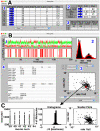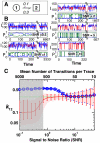Single Molecule Analysis Research Tool (SMART): an integrated approach for analyzing single molecule data
- PMID: 22363412
- PMCID: PMC3282690
- DOI: 10.1371/journal.pone.0030024
Single Molecule Analysis Research Tool (SMART): an integrated approach for analyzing single molecule data
Abstract
Single molecule studies have expanded rapidly over the past decade and have the ability to provide an unprecedented level of understanding of biological systems. A common challenge upon introduction of novel, data-rich approaches is the management, processing, and analysis of the complex data sets that are generated. We provide a standardized approach for analyzing these data in the freely available software package SMART: Single Molecule Analysis Research Tool. SMART provides a format for organizing and easily accessing single molecule data, a general hidden Markov modeling algorithm for fitting an array of possible models specified by the user, a standardized data structure and graphical user interfaces to streamline the analysis and visualization of data. This approach guides experimental design, facilitating acquisition of the maximal information from single molecule experiments. SMART also provides a standardized format to allow dissemination of single molecule data and transparency in the analysis of reported data.
Conflict of interest statement
Figures






References
-
- Weiss S. Fluorescence spectroscopy of single biomolecules. Science. 1999;283:1676–1683. - PubMed
-
- Lu HP. Probing single-molecule protein conformational dynamics. Acc Chem Res. 2005;38:557–565. - PubMed
-
- Joo C, Balci H, Ishitsuka Y, Buranachai C, Ha T. Advances in single-molecule fluorescence methods for molecular biology. Annu Rev Biochem. 2008;77:51–76. - PubMed
-
- Ambrose WP, Goodwin PM, Jett JH, Van Orden A, Werner JH, et al. Single molecule fluorescence spectroscopy at ambient temperature. Chem Rev. 1999;99:2929–2956. - PubMed
Publication types
MeSH terms
Grants and funding
LinkOut - more resources
Full Text Sources
Miscellaneous

